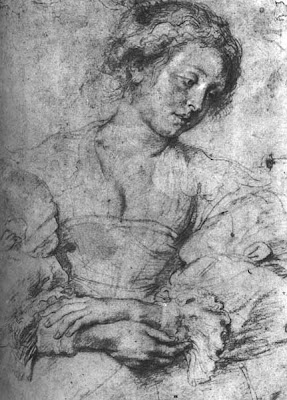Drawing facing the reversal of values
It happened many times in history. An artist appeared and paved a new way and many admirers and shades started to follow it. A century later people changed their taste. The works of art representing a valid ideal of beauty suddenly changed into examples not worthy to follow, not worthy to deal with. The ideals lost their validity.
Michelangelo:
This instability of values can be discomforting to someone. We like order of things valid yesterday, today and tomorrow too. If a gold was a gold and a shit was a shit, we have unconscious desire to maintain this order of values forever. The problems start if the order is inverted, when the gold becomes a shit and vice versa. Especially the older generations start paying attention, because they suspect attack on the society foundation, which they built for ages with great effort. On the contrary the young generation perceives this change of taste as a development and progress.
So that is the flow of history. We dedicate our youth to progress and we ward off the attacks on the society foundation when getting old. It is uneasy to keep distance here. How can we apprehend objectively this change of taste and values? Is it really a decline or is it progress moving the limits further?
Hans Holbein the younger:
With the turn of the century came a new means of grasping the ways in which the mind plays with elements of sensory experience and out of them shapes new patterns.
Classical civilization and it's values were shaken, when romantics began sought out the primitives, which a few centuries later led to an interest in Negro sculptures among the Cubists. There is a remarkable difference in what was considered as "a painting" by Renaissance master and what is considered as "a painting" in contemporary gallery – many times a Renaissance master would not even think of it as of painting.
I noticed a shift in perceiving of old masters drawings. The virtuosity of it was balanced by decades of hard work. The attitude of a pretentious modern artist changed a lot towards such art as he considers it to be obsolete now. Here lies a reason behind my decision to create a mini show of the giants acknowledged by history, who reached the highest level of the challenging "craft". I think it is pretty distant from the contemporary discipline called "drawing", where there is enough to draw a twisted line and proclaim it as interpretation of mutual relationship and energy, which we can or do not have to see.
Leonardo da Vinci:

Raphael Santi:
Selfportrait. You can estimate Raphael's age here to be the teenager in his bloom. That's why we are staggered by the maturity and perfection of drawing.
Pope Julius II
The portrait of a girl with enticing glance and mysterious smile gives suggestion, that Raphael was very aware of Leonardo's paintings, particularly of Mona Lisa. He could adopt the most essential features into his works. Just imagine a peasant, not much aware even of his own name, entering a church after a whole week of toil and facing such a seductive glance and smile of beautiful Madona on an altar painting, he never even dreamed of. Would not you be looking forward to visiting the church regularly and meeting with such a glamour? Would not you be looking forward to entering the Paradise? The art was that powerful...

Peter Paul Rubens:






2 comments:
Genial brief and this enter helped me alot in my college assignement. Thanks you on your information.
Sorry for my bad english. Thank you so much for your good post. Your post helped me in my college assignment, If you can provide me more details please email me.
Post a Comment